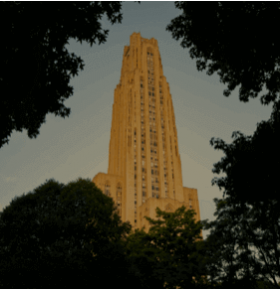
Subscribe to Pittwire Today
Get the most interesting and important stories from the University of Pittsburgh.So, what research was Secretary of State Antony Blinken privy to during his recent visit to the University of Pittsburgh?
Amy Hartman, associate professor of infectious diseases and microbiology, had the opportunity to show him the cause of the COVID-19 pandemic in microscopic detail (see image at the top of this story).
Under the lens was an image of SARS-CoV-2-infected cells that had been stained with fluorescent antibodies to help visualize the virus’s spike protein and trace its destructive path. The image also encapsulated the major research focus for Pitt’s Center for Vaccine Research (CVR) for almost the past two years.
Hartman and other Pitt researchers have been at the forefront of the COVID-19 research response, which was one of the reasons Blinken toured CVR. It was one of the first facilities in the United States to receive samples of the novel coronavirus, and CVR researchers and their collaborators across the globe have since made significant contributions toward understanding the virus’s biology and developing promising treatments. Hartman cites early CVR efforts to understand the course of the disease and how the virus replicates as work of which she is most proud in the battle against coronavirus.




The image of SARS-CoV-2-infected cells Blinken saw was created by Sham Nambulli, a research scientist with CVR and member of Jonas Salk Chair for Vaccine Research and CVR Director Paul Duprex’s lab. Nambulli is part of the team that genetically engineered the measles vaccine to act as a potential vaccine for coronavirus. This group also collaborated with Yi Shi, assistant professor of cell biology, to develop “nanobodies” cloned from a llama that could become inhalable drugs to treat and prevent COVID-19. On the day of the visit, Nambulli showed Blinken the negative air pressure lab and how he and other researchers work with the coronavirus.
The secretary also learned how cows may help lead us out of the pandemic. Maria D.H. Alcorn, postdoctoral associate in associate professor of immunology William Klimstra’s lab, has been part of a team developing an antibody treatment for COVID-19 with the help of genetically modified cows raised in South Dakota. During the visit, Alcorn and Dominique J. Barbeau, lab manager, were stationed in biosafety cabinets, illustrating techniques that are used with in vitro culture of SARS-CoV-2 to give Blinken a more complete understanding of the range of work done in CVR. (Barbeau normally works on comparing long-term immune responses to COVID-19 vaccines with Anita McElroy, assistant professor of pediatrics.)
For Hartman, Blinken’s visit was not only a chance to showcase CVR’s work to battle COVID-19 but to provide a better understanding of what it takes to do scientific research in emerging viruses.
“We all presented the complexity and the cost of doing this type of research,” says Hartman. “I think he was impressed by the truly global nature of biomedical research and how we’re all working together toward a common goal.”


